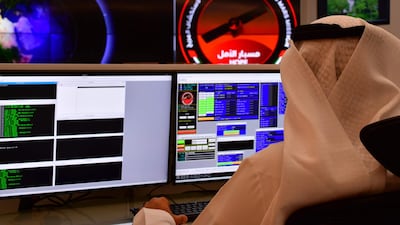A Japanese rocket carrying the Arab world’s first Mars-bound spacecraft is parked inside a building just a short distance from the launch pad.
It will remain there until the Emirates Mars Mission team and the launch service provider – Mitsubishi Heavy Industries – find a day with suitable weather conditions for a rocket launch.
The mission, which cost Dh745 million and took six years to develop, has been delayed twice already this week with a launch window of August 3 narrowing by the day. If missed, it will not be taking off until 2022.
“We are going to be busy with our daily meetings that determine the weather and launch status,” said Omran Al Sharaf, project manager of the mission during a virtual media briefing on Tuesday.
“The team in Dubai is bringing in the plans we had made in case of delays into action.”
The first launch attempt on July 15 was scrubbed and the July 17 date was also pushed back because of unstable weather at the launch site in Tanegashima. A new date is expected to be announced by Thursday morning.
The Hope probe, a spacecraft that is a size of a small car, is inside the payload fairing and is mounted on top of the 53-metre-tall H-IIA rocket.

The rocket is inside the Vehicle Assembly Building, which is an 81-metre-high facility used to assemble a spacecraft onto a rocket and then it is rolled out to the launch pad.
Until the team decides on a new launch date, the Emirati engineers will be monitoring the Hope probe to ensure it remains in optimal working order.
“We continue to ensure the spacecraft is in good condition,” said Mr Al Sharaf.
“We planned everything to happen on the 15th, but with the delay there is now a gap. So, we need to make sure the batteries are at the right level and that the environment that is set around the spacecraft is maintained.”

Meanwhile, another group of Emiratis and MHI officials are carrying out thorough weather checks for a potential launch day.
The weather on the island continues to be turbulent, with heavy rainfall and strong winds.
Several factors decide when the launch day will be, including the cloud density, winds and amount of precipitation.
Unstable weather can interfere with rocket launches and can damage the rocket and spacecraft.
According to weather forecasts, there are a few ‘mostly sunny’ days in Tanegashima after July 20.
Mr Al Sharaf said they will use the earliest launch opportunity available within the small launch window. There could be gaps of one to five days each time a delay is announced.
There have been a few obstacles in the path of the UAE’s Mars mission, including the onset of the coronavirus pandemic, and now the race to launch within such a short time frame.
The probe and engineers were sent to the launch site ahead of schedule due to the Covid-19 travel restrictions. Some of them have been on the remote island since April 5.
All of them had to spend 15 days in quarantine in Tokyo before going to Tanegashima.
The Hope probe aims to study the climate of the Red Planet and will analyse the relationship between its upper and lower atmosphere.
The data will be shared for free with researchers all over the world.








